#Allosaurid Theropod
Text
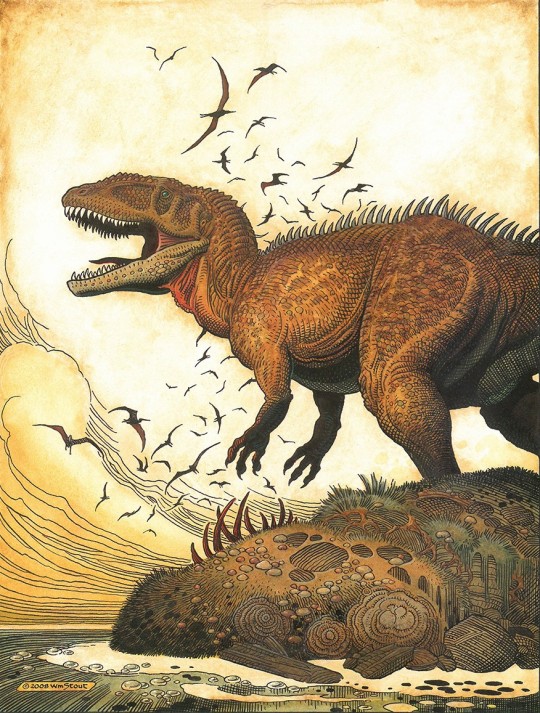
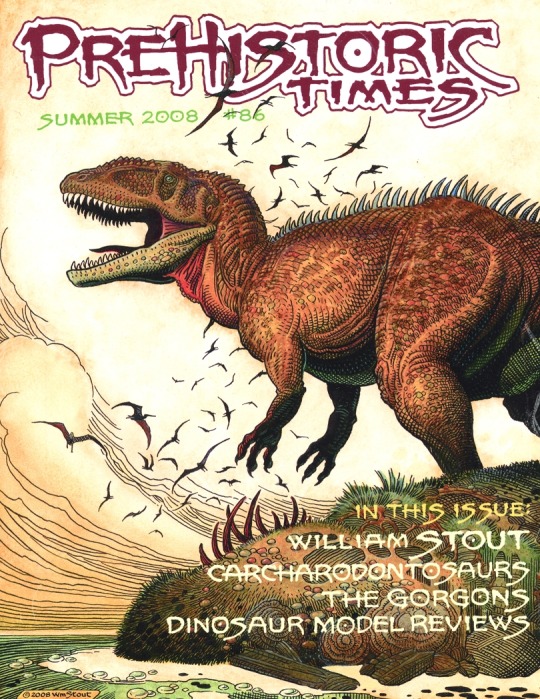
"..."SHARK-TOOTHED LIZARD," AN ALLOSAURID THEROPOD FROM MID-CRETACEOUS NORTH AFRICA."
PIC(S) INFO: Spotlight on the original painting and published cover art to "Prehistoric Times" Magazine #86 (Summer 2008), artwork by William Stout, featuring a Carcharodontosaurus “shark-toothed lizard”, an allosaurid theropod from mid-Cretaceous North Africa.
EXTRA INFO: Carcharodontosaurus is a representative of a family of dinosaurs that may well turn out to be the largest meat-eating dinosaurs of all.
Resolution at 876x1157 & 810x1048.
Sources: www.illustrationhistory.org/artists/william-stout & https://blog.everythingdinosaur.com/blog/_archives/2008/07/21/3803292.html.
#Palaeo Art#William Stout Art#Carcharodontosaurus#Prehistoric Art#Prehistoric#Prehistoric Times#Dino Art#Dinosaurs#Dinosaur Art#Allosaurid#Mid-Cretaceous#Shark-Toothed Lizard#Illustration#Prehistory#North Africa#Allosaurid Theropod#Dinos#Theropods#Prehistoric Times magazine#Magazines#Dinosaur#Prehistoric Times Magazine#William Stout Artist#William Stout#Mid-Cretaceous North Africa#Cover Art
2 notes
·
View notes
Text

Allosaurus sketchbook doodle. If anything looks wonky it's because when I started it I didn't have a reference with me.
#art#my art#traditional art#graphite drawings#paleoart#paleontology#palaeoblr#archosaurs#dinosaurs#theropods#allosaurids#allosaurus#queue
33 notes
·
View notes
Text
Metricanthosaurus Parkeri

Metricanthosaurus was a large metriacanthosaurus that dominated the area of what is now known as England 160 million years ago during the late Jurassic period. Being part of the larger group allosauridea along with allosauridae and carcharodontosauridae. Metricanthosaurus was discovered in the year 1871 in the oxford clay formation which is located in southeast england. Although metriacanthosaurus is a well known theropod, so far there has only been one specimen, which included an incomplete hip, a leg bone, and part of a backbone.
Stats:
Length: 30ft (9.1 m)
Height: 9ft (2.7 m)
Weight: 2,200 lb
Area: England, UK
Time: 161.2 - 155.7 mya
Formation: Oxford Clay Formation
Family: Metricanthosauridae
Species: M. Parkeri
For more information check out the video I made on it:
youtube
Reference:

#dinosaur#paleoart#dinos and comics#art#artwork#dinosaurs#allosaurid#theropod#allosaurus#jurassic world#dinosaur art#paleontology#paleoillustration#prehistoric#foryou#Youtube
26 notes
·
View notes
Text

Allosaurus.
#art#digital art#illustration#paleo#palaeoblr#paleoart#prehistoric#reptile#archosaur#dino#dinosaur#dinosaurs#saurischian#theropod#allosaurid#allosaurus#extinct#extinct animals#dinovember#dinovember2022#stripey creachur
92 notes
·
View notes
Text

An Allosaurus skeleton in the natural history museum in Basel. It was great, but to be honest I only had eyes for the Deinonychus you can spot in the bottom right corner.
#allosaurus#allosaurid#theropod#dinosaur#jurassic#skeleton#i like dromaeosaurs and i cannot lie#sorry allosaurus#you're standing next to the star of the museum#palaeoblr
7 notes
·
View notes
Photo
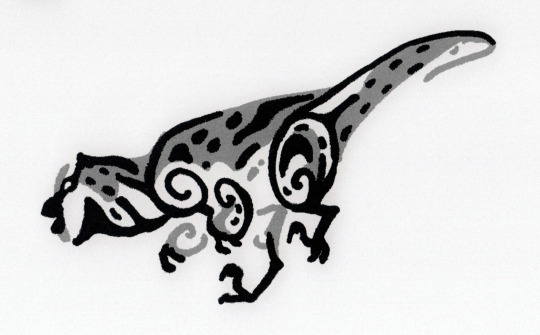


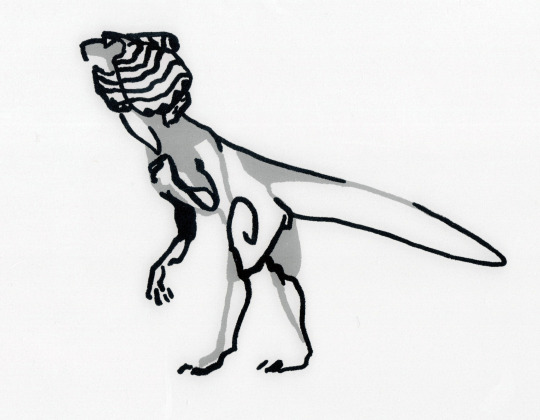
A collection of theropods.
Lesser spotted owlcat, a small, semiarboreal nocturnal predator. Like other owlcats, they hunt by ambush, targeting primarily birds and other flighted small prey.
Bell runner, a goose-sized dromaeosaur which favors small prey and insects. Although they do not hunt in packs, they are social and groups of bell runners can often be seen hunting together in grazed fields.
Bedejou, a large allosaurid native to the open, dry woodland straddling the Zaroub and the Great Lakes basin. The white rings around their eyes grant them a stare that legends describe as petrifying.
Antiole, a species of sapient theropods, the only sapient species of this setting. Antioles are true omnivores and highly social, forming complex societies with a wide variety of languages, social norms, and cultural practices.
#tritone#spec bio#speculative biology#worldbuilding#paleoart#ish#antiole world#antiole#owlcat#dromaeosaur#allosaurus#theropod
1K notes
·
View notes
Text
It Came From The Wastebasket #07: Carnosaur Carnage
Carnosauria was originally named in the 1920s as a grouping for all of the large-bodied theropod dinosaurs known at the time.
For much of the 20th century it was used as a general wastebasket taxon collecting together all big carnivorous forms – including allosaurids, carcharodontosaurids, megalosaurids, spinosaurids, ceratosaurids, abelisauroids, and tyrannosaurids – and for a while it even included a species that later turned out to be closer related to crocodiles than to dinosaurs.

From left to right: Asfaltovenator vialidadi, Torvosaurus tanneri, Giganotosaurus carolinii, & Baryonyx walkeri
But then cladistic analysis in the 1980s and 1990s revealed that some of these theropods weren't actually closely related at all. Carnosaurs weren't a natural lineage but instead were highly polyphyletic, with the physical similarities between them seeming to be more due to convergent evolution than direct shared ancestry.
Some carnosaurs were split off and reclassified as more "primitive" types of theropod, while the tyrannosaurs were placed much closer to birds with the coelurosaurs. The remaining "carnosaurs" were just the allosaurids, carcharodontosaurs, and their closest relatives, and some paleontologists now prefer to use the name Allosauroidea for this group to distance it from the previous wastebasket mess.
…But Carnosauria might not be done just yet.
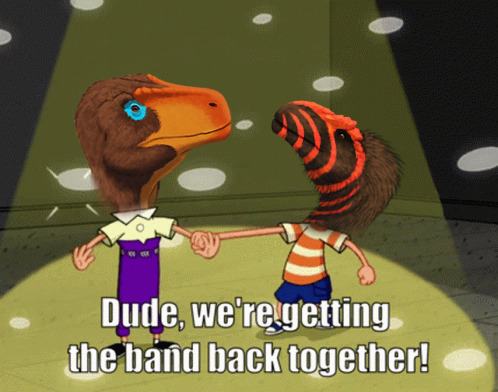
The discovery of Asfaltovenator in 2019 complicated matters once again, with a mixture of anatomical features linking it to both the allosauroids and the megalosauroids (megalosaurids, spinosaurids, and their relatives) – suggesting that these two groups might actually have been closely related to each other in a single lineage after all.
This would potentially return Carnosauria back to something surprisingly close to its original definition, with the various megalosauroids now forming an evolutionary grade leading to the allosauroids.
———
Nix Illustration | Tumblr | Twitter | Patreon
#it came from the wastebasket#wastebasket taxon#taxonomy#carnosaur#asfaltovenator#torvosaurus#giganotosaurus#baryonyx#theropod#dinosaur#paleontology#art#science illustration#paleoart#palaeoblr
339 notes
·
View notes
Text
When I was a kid Tyrannosaurus rex was my all time favorite dinosaur, and is still in my top three
The other two are Carcharodontosaurids. The first is this one.
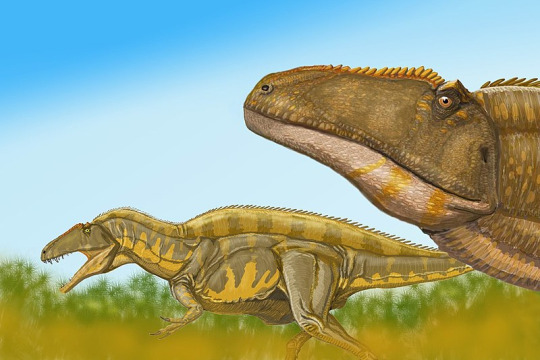
Acrocanthosaurus not only is actually native to North America, but is something of a real life mashup of aspects of all the elements of the 'classic scary giant theropod.' A spine like a Spinosaurid, size to rival Tyrannosaurus, and the basic elements of the super-allosaurid sauropod hunters the Carcharodontosaurids were.
It's become one of my favorite theropods precisely for this reason and makes an ideal creature for a vision of the dinosaur era.
25 notes
·
View notes
Link


An article published in the journal "PeerJ" reports the identification of a new species of carnivorous dinosaur that lived between 152 and 157 million years ago, in the Jurassic period. Daniel Chure and Mark Loewen named it Allosaurus jimmadseni after examining various fossils discovered in the 1990s in Utah and Wyoming to determine that it's a new species of allosaurus, a few million years older than the first one discovered, Allosaurus fragilis. The differences between the two species suggest different eating habits.
0 notes
Text

Archovember Day 6: Guanlong wucaii
Long, long before Tyrannosaurus rex stomped its way through North America, a very different Tyrannosauroid lived across the world in late Jurassic China. Guanlong means “crown dragon,” and one look at it tells us why. This small Tyrannosauroid had a delicately thin yet large crest on its head, likely used for display.
Unlike later tyrannosauroids, Guanlong had long, three-fingered hands that it could use to grab and tear at prey. Being a mid-size predator, it would have hunted smaller dinosaurs but also served as prey for larger theropods like the allosaurid Yangchuanosaurus. It was about the size of the Raptors on Jurassic Park.
#my art#Guanlong wucaii#Guanlong#tyrannosauroids#theropods#saurischians#dinosaurs#archosaurs#archosauromorphs#Archovember#archovember 2021#draw dinovember#draw dinovember 2021#dinovember#dinovember 2021#SaritaDrawsPalaeo
37 notes
·
View notes
Text
A Dragonchoice day out
Dragonchoice - You Choose: Candidate is nearing launch (and Search is still open at https://www.dragonchoice.com/you-choose!) - but the UK contingent of the Dragonchoice dev team recently had a weekend out in London!
Dragonchoice writer/game designer Faye Upton, artist and test lead Chris S. Baily, and 3D artist Mat Baily visited the Science Museum, Natural History Museum, and London Zoo in search of inspiration - and found quite a lot!
Chris did a lot of sketches, and here are the results (plus a bonus photo!)

We just had to take a photo when we came across this specimen of everyone's favourite drinking game magnet at the Natural History Museum! This is actually the first time I've seen this particular species of Draco lizard - not the more common Draco volans that many people seem fascinated with as a "real life dragon." I do wish that the London Zoo had had some live Draco of any species - that would have been pretty awesome to see, since they're pretty delicate animals, and somewhat difficult to keep in captivity.
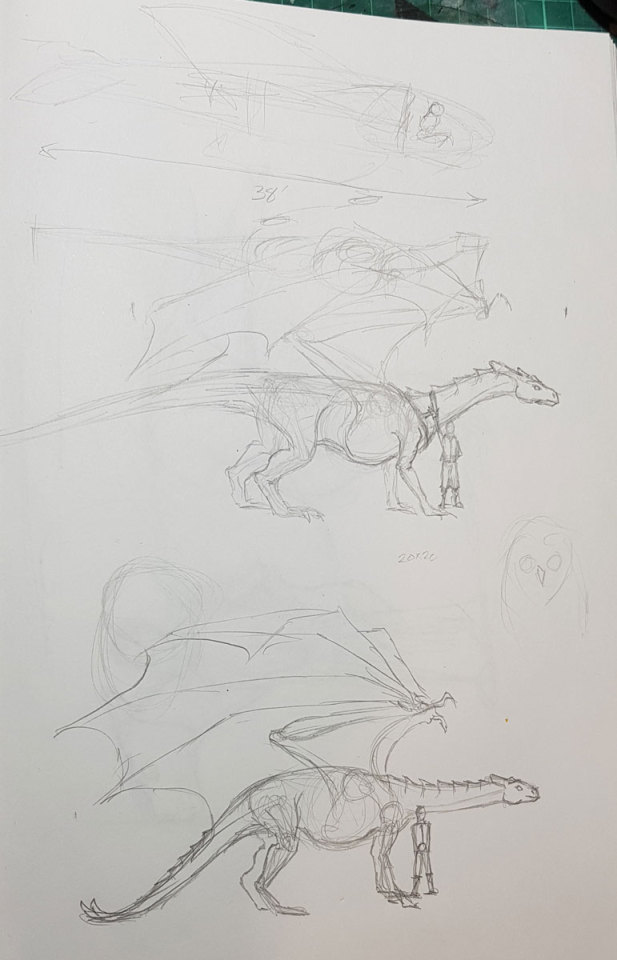
This was my first sketch of the weekend, in the Science Museum - looking up at the various small planes hung from the ceiling to get a good mental picture of fighter-plane size. The rough plane sketch is a Lockheed 10A Electra, 38' nose to tail.
Below it, I'd been thinking about the actual overall proportions of Pernese dragons, and what works for my personal aesthetic preferences, the overall "feel" of the dragons from the books, and the bits of descriptive content we actually get. I've added a couple of approximately 38' dragons - a rather long-necked, small-headed and short-tailed fellow, and a more typically proportioned longer-tailed dragon, with my usual favourite fella for scale, the 6-foot-tall B'nana. The 42'ish fellow feels more like a blue to me than, say, the largest queen dragon ever.
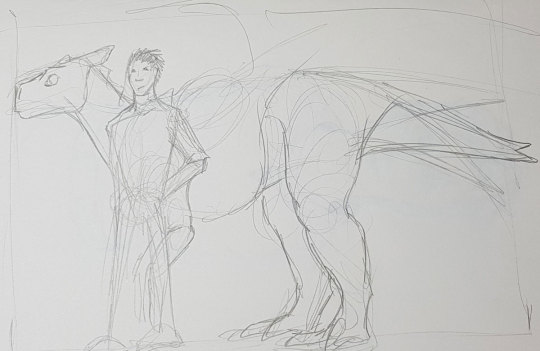
We know from descriptions in Dragonsdawn that Carenath is meant to be just over 16 hands high (5'4") at the shoulder the first time that Sean rides him - but there are some figures given in the DLG and by AIVAS suggesting that he's meant to be visibly smaller than Ruth at 18' nose to tail. That leaves us with some really weird proportions (although this is exaggerated!) - and I have to admit, this particular dragon build is very much a "Thanks, I hate it!" I can say with some certainty that I do not believe that Carenath is this short of neck, body or tail, because there's really nothing graceful about that.

Of course, the highlight of any trip to any natural history museum is the dinosaurs. It's no secret that most of my dragons are based on generally dinosaur-like ideas - so these are pushing the dinosaur resemblance to the extreme, to see if there is a build and body shape that really looks like it works.
The large fellow ("Girth") in the middle was based on NHMUK R5674 - Mantellisaurus, the iguanodont in the entry hall of the museum. This feels a little too short in the neck for me, and visually speaking although the shoulder height isn't bad for a green, I'd want probably a third again the length to really balance her out - 20' nose to tail just doesn't work here for me.
In the upper left we've got "Width" - a generic medium-theropod based dragon (something sort of small Allosaurid) - again, 20' nose to tail - and again, too short in the neck, although I think the forelimbs are closer.
Then, down in the lower left, we've got "Length" - who is based on the sauropod dinosaur Camarasaurus (scaled down to the 20-foot length we're using for reference) - although I quite like the proportion of those legs and she looks like she'd have that skip-hop gait, she'd need to be at least twice the size (height and length) to be even a green in terms of shoulder height that's described in the books - popping her up to around 40' nose to tail.
And lastly, in the upper right, you've got "Yeth" - who is closer to my usual dragon proportioning - and again, would be too short in the shoulder to be the right size for a green.
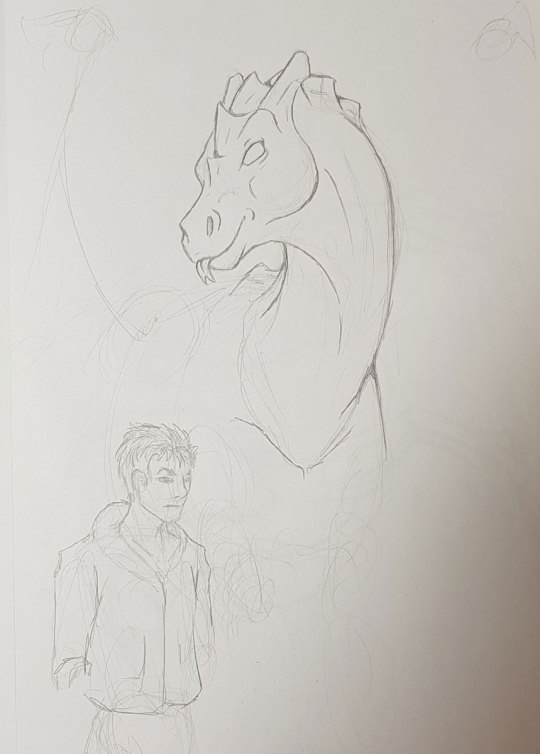
This one was a random doodle that wanted to happen while I was sitting in Dragonchoice Central, the room where the fanfic magic happens - mostly to explore "can I draw something recognisably humanlike" (IMO the answer is still "not really, not without references!")
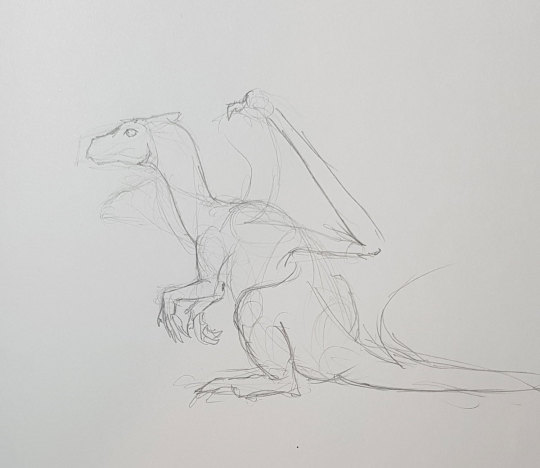
This one was a very sketchy one because it was drizzling lightly - this was day 2, at the London Zoo. I do really want to explore the "walking posture" of a kangaroo for Pernese dragons - it's that awkward hop-skip.
So that was the Dragonchoice team building day out – featuring ancient monsters, modern lizards, vintage aircraft and the odd live animal! And hopefully we’ll have whetted your appetite for some of the art that will feature in Dragonchoice – You Choose: Candidate!
10 notes
·
View notes
Video
youtube
At last, a high-definition Survival Horror game with Dinosaurs in it. Hoping that a) it actually makes it to release and b) it’s damn good.
So far eschewing His Majesty, I commend the developers choosing to focus on some kind of Allosaurid(?) as the main threat, with some dromaeosaurids(?) for flavour and different area pressures. Even more interesting, there seems to be more than one of the bigger animals on the screen all at once, so I wonder how that would play out. Do they compete, work together or is it simply a wandering mass of teeth and muscle for you to blunder into when backing away from another.
If I could make one request of this game from what I’ve seen so far, it’s that the idea that they’re real animals and not mindless eating machines is upheld at all times. Like when the deer is killed in the intro, the predator simply wards you off from its meal or ignores you entirely, given your size, choosing to feed right there or saunter off with it. If they want to sell it as real animals and real reactions, they’d better make sure that after stalking and catching prey, they don’t immediately decide to drop it when faced with a bony, gristly ape.
Well, until you’re the only thing immediately available and nothing easier is around. Then you’re definitely on the menu.
Going back to that first point I made, if there really has has to be a Tyrannosaurus in it (I don’t dislike the idea, it’s just most of the things seem Jurassic era), it’s used either sparingly as a Nemesis style figure or an end boss. Give its presence meaning and weight. Maybe even as an incidental encounter, setpiece or even as an assist, if it doesn’t view you as worth chasing.
I’d like the latter options, actually. Heck, imagine a “safe zone” where it’s the T-Rex’s territory and smaller carnivores won’t dare bother you and the great big one is just sort of milling around, minding its own business. Just don’t get too close though: it’s like a Great White in that it’ll use its mouth to investigate things and you’re oh-so squishy.
Speaking of biting theropods, when the Allosaurus(?) grabs the protagonist, I wonder if it’s instant death or break-outable. On one hand, a weak bite force for its size, on the other, teeth like steak-knives and a powerful neck and body for thrashing you around. Not to mention claws. I’d like for them to use their claws too. You’d likely need a flare, flare-gun or knife in order to persuade them to let go otherwise. Health and first-aid might be a bit pointless when the main threat just opens you up.
I’m hoping for dangerous herbivores too. Not all of them, obviously, but a Stegosaurus? Wary of small, fast things like you and has a fire-and-forget response with those thagomizers. Sauropods? Big, heavy and don’t look where they’re going. Collapsing trees and muddying the ground, creating a slowing, quicksand effect if you’re not careful. Even a little ornithiscian that gives out a loud alert cry if you spook it, spoiling your hiding place and making things with sharp teeth take an interest in that direction.
So, yeah, watching this one’s career with great interest.
#The Lost Wild#Not gonna lie... this looks DAMN promising.#It actually fulfills a lot of what I wanted from a Dinosaur Survival Horror as far as style goes#they're 'AI smart animals' so hopefully they'll look at corpses in an equal or superior light to the lady running around with a flare gun#really hope it makes you think about what you're doing and what's available like Alien: Isolation
11 notes
·
View notes
Text
Allosauruses

Allosaurus was part of a family called Allosauridae which in turn is part of the superfamily Allosauridae. This family included Metriacanthosauridae, Carcharodontosauridae, Neovenatoridae and of course Allosauridae. Now there are many species of Allosaurus including Allosaurus Fragilis, Allosaurus Jimadensi, Allosaurus Europus, and the very controversial “saurophaganax”. Allosaurus Fragilis is perhaps the most well known of these 3 or 4 as over 60 individuals of this creature have been discovered. We can not say the same for Saurophaganax however as only fragmentary fossils of it have been discovered leading to debates whether it was a large individual of Allosaurus fragilis or a completely different species, or even a different genus!
Check out my Youtube channel where I post speed paints (of this and other stuff) stopmotions, and animations:
www.youtube.com/@jarvistheallo…
#paleoart#dinosaur#dinos and comics#art#artwork#dinosaurs#allosaurid#theropod#carcharodontosauridae#allosaurus#prehistoric
57 notes
·
View notes
Text

Ey, if it isn’t everyone favorite gay murdering piece of shit. Yeah I drew and designed TFC Heavy before Ms Pauling or The Administrator. I just love how cocky he is. Like my man is worse than Scout and that’s saying something. Also, my first time properly shading by blurring it! Hurray! (And no I’m not talking about the glow). Anyways, let’s get to the design portion.
CHeavy is a yutyrannus. This is to parallel with Heavy being an allosaurus. Allosaurus is native to what is modern day Russia, and yutyrannus lived in cold conditions. They both had crests, and both were large apex theropods. They were opposites as well though, with yuty being in the tyrannosaurid family and allo being in the- well.. allosaurid family. Yuty was also covered in a coat of downy feathers, while allo remained naked and covered in scales. This also somewhat fit, seeing as CHeavy has hair and Heavy does not. I changed his scar to three lines instead of one because in this “au” Medic slashed him with his claws instead of a saw. I gave him similar crest patterns as Heavy seeing as they are technically the same class. Also I was too lazy to look up the symbols of the TFC team so idk if they’re the same or not. The small amount of blue he has on him is not patterning spread over several scales, but actually large, differently colored scales. This is because the stripes on his armbands reminded me of the scales on bird legs. I gave him some light gray face patterning to sort of represent his hair/aging. The stripes are meant to represent the straps of his vest, and the underbelly is just stylistic choice. I like to think he used to be far more vibrant, and his gray feathers used to be a bluish black, before graying in age. The face features always gray first if my dog is any example.
Welp, that’s it! Thanks for reading!
#dinosaurs#tf2#tf2 heavy#team fortress two#team fortress#team fortress 2#team fortress fanart#team fortress comics#team fortress classic#tfc heavy#yutyrannus#tf2 fanart#tf2 fandom#tf2 comics
16 notes
·
View notes
Photo

Is a genus of large carnosaurian theropod dinosaur that lived 155 to 145 million years ago during the Late Jurassic epoch (Kimmeridgian to late Tithonian). The name "Allosaurus" means "different lizard" alluding to its unique (at the time of its discovery) concave vertebrae. It is derived from the Greek ἄλλος (allos) ("different, other") and σαῦρος (sauros) ("lizard / generic reptile"). The first fossil remains that could definitively be ascribed to this genus were described in 1877 by paleontologist Othniel Charles Marsh. As one of the first well-known theropod dinosaurs, it has long attracted attention outside of paleontological circles. Allosaurus was a large bipedal predator. Its skull was light, robust and equipped with dozens of sharp, serrated teeth. It averaged 10 meters (33 ft) in length, though fragmentary remains suggest it could have reached over 12 m (39 ft). Relative to the large and powerful hindlimbs, its three-fingered forelimbs were small, and the body was balanced by a long and heavily muscled tail. It is classified as an allosaurid, a type of carnosaurian theropod dinosaur. The genus has a complicated taxonomy, and includes three valid species, the best known of which is A. fragilis. The bulk of Allosaurus remains have come from North America's Morrison Formation, with material also known from Portugal. It was known for over half of the 20th century as Antrodemus, but a study of the copious remains from the Cleveland-Lloyd Dinosaur Quarry brought the name "Allosaurus" back to prominence and established it as one of the best-known dinosaurs. As the most abundant large predator in the Morrison Formation, Allosaurus was at the top of the food chain, probably preying on contemporaneous large herbivorous dinosaurs, and perhaps other predators. Potential prey included ornithopods, stegosaurids, and sauropods. Some paleontologists interpret Allosaurus as having had cooperative social behavior, and hunting in packs, while others believe individuals may have been aggressive toward each other, and that congregations of this genus are the result of lone individuals feeding on the same carcasses.
Carnivore
Allosaurus (c) Jurassic World
Art (c) reneg661
2 notes
·
View notes
Text
Australovenator wintonensis

By Scott Reid
Etymology: Southern Hunter
First Described By: Hocknull et al., 2009
Classification: Dinosauromorpha, Dinosauriformes, Dracohors, Dinosauria, Saurischia, Eusaurischia, Theropoda, Neotheropoda, Averostra, Tetanurae, Orionides, Avetheropoda, Megaraptora, Megaraptoridae
Status: Extinct
Time and Place: About 95 million years ago, in the Cenomanian of the Late Cretaceous


Australovenator is known from the Phimopollenites Pannosus Pollen Zone of the Winton Formation in Queensland, Australia
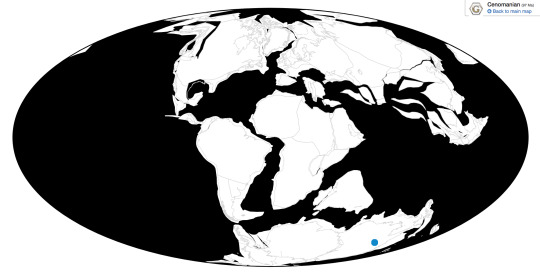
Physical Description: Australovenator was a Megaraptor, a group of fairly mysterious predatory dinosaurs that consistently confuse people since they were first discovered through today. The known parts of Australovenator are rather sparse - limbs and some parts of the torso, and a bit of the tip of the mouth. These elements show an animal with long legs, fairly long arms (for a theropod) with giant hand claws, and a slender jaw. The rest of our understanding of its size and shape is really based on its relatives. It would probably have been 6 meters long and 2 meters tall, weighing only 1,000 kilograms - making it a very lightweight, potentially fast predator. It had extremely flexible hands as well - more flexible than other theropods, almost able to pronate (ie, make “bunny hands”, which is not possible in other theropods). It also had extremely strong feet, built for kicking. Given that it was slender and small, it would have probably been covered in fluffy protofeathers all over its body.

By Ashley Patch
Diet: Australovenator would have been a major predator, able to eat a wide variety of small and medium sized animals in its environment - potentially even larger animals if it was able to work in groups.
Behavior: The behavior of Australovenator is not greatly known, given how mysterious Megaraptorans are as a general group. However, the extremely strong foot bones found with extensive signs of breakage indicates that Australovenator did use its feet to kick at prey, similar to modern emus. This would have greatly bruised and damaged the prey, potentially even breaking bones and causing internal bleeding and organ damage. The extremely flexible arms would have allowed it to use them to manipulate objects, grab at food, and easily claw at prey. In fact, the very large hand claws are notable for the Megaraptorans, since they were originally thought to be the giant foot claws of giant Dromaeosaurs. This ability to claw at and maim prey would have helped Australovenator extensively in taking down prey.
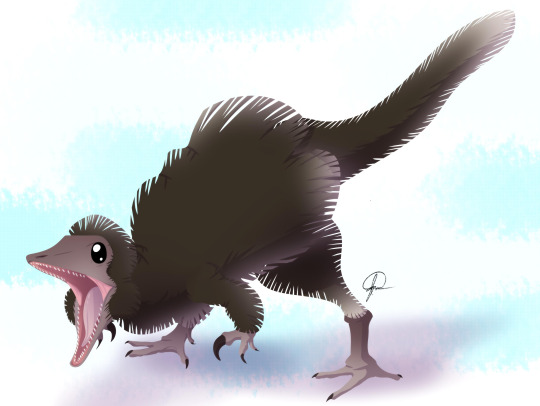
By José Carlos Cortés
Were Megaraptorans social? We aren’t sure. Australovenator was a powerful predator, clearly able to take down other animals in its environment without much help. It may have worked in small groups in order to get food larger than it, such as the sauropod Diamantinasaurus, since there weren't larger predators in its environment. However, there is no direct evidence to support that. Furthermore, in plenty of locations, Megaraptorans are very rare, indicating they wouldn’t have grouped up together much. Still, they usually aren’t the largest predators in a place, so the jury is out for Australovenator. As a dinosaur, it would have probably taken care of its young, though in what way is a question.
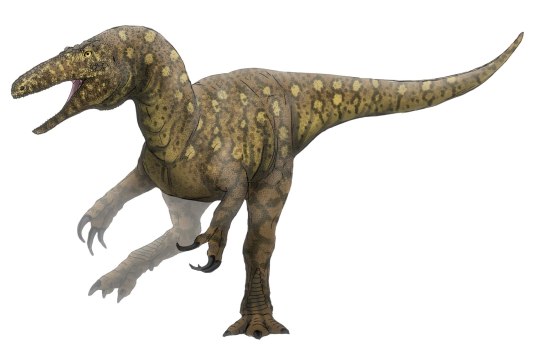
By PaleoEquii, CC BY-SA 4.0
Ecosystem: The Winton Environment was a river basin, next to the former inland Eromanga Sea. This was a highly forested ecosystem with extensive swamps, creeks, lakes, and estuaries leading back to the sea. The dense vegetation made it a hotbed for herbivores, which were all sources of prey for Australoveantor. In fact, Australovenator was found directly with Diamantinasaurus, a 15 to 16 meter long sauropod (indicating that Australovenator may have been scavenging, or worked in a group and was killed by a group member). Other herbivores included the titanosaurs Wintonotitan and Savannasaurus, and the Somphospondylian Austrosaurus. There were a variety of Ornithischians there, though none were named, they may have been Rhabdodonts or Elasmarians; and there was at least one Ankylosaur (probably a basal Ankylosaurid). In addition, there was the large pterosaur Ferrodraco, and the narrow-snouted Crocodylomorph Isisfordia.

By Ripley Cook
Other: Megaraptors like Australovenator are a taxonomical quagmire. They are either closely related to the Carnosaurs - animals like Allosaurus and Giganotosaurus - or to early Coelurosaurs such as the Tyrannosaurs. It’s possible they are Tyrannosaurs, full stop, but an early group of them. Honestly, the question is still up in the air - but they combine a lot of the characteristics of the earlier theropods with the more bird-like ones, which leads to this confusion. Regardless, Australovenator was a very late derived Megaraptor, nested deep within the group.
~ By Meig Dickson
Sources Under the Cut
Agnolin, F. L., M. D. Ezcurra, D. F. Pais and S. W. Salisbury. 2010. A reappraisal of the Cretaceous non-avian dinosaur faunas from Australia and New Zealand: evidence for their Gondwanan affinities. Journal of Systematic Palaeontology 8(2):257-300.
Apesteguía, Sebastián; Smith, Nathan D.; Valieri, Rubén Juárez; Makovicky, Peter J. (2016-07-13). "An Unusual New Theropod with a Didactyl Manus from the Upper Cretaceous of Patagonia, Argentina". PLOS ONE. 11 (7): e0157793.
Benson, R. B. J., M. T. Carrano, and S. L. Brusatte. 2010. A new clade of archaic large-bodied predatory dinosaurs (Theropoda: Allosauroidea) that survived to the latest Mesozoic. Naturwissenschaften 97:71-78.
Brougham, T., E. T. Smith, and P. R. Bell. 2019. New theropod (Tetanurae: Avetheropoda) material from the ‘mid’-Cretaceous Griman Greek Formation at Lightning Ridge, New South Wales, Australia. Royal Society Open Science 6:180826:1-18.
Carrano, M. T., R. B. J. Benson, and S. D. Sampson. 2012. The phylogeny of Tetanurae (Dinosauria: Theropoda). Journal of Systematic Palaeontology 10(2):211-300.
Csiki-Sava, Z., S. L. Brusatte, and S. Vasile. 2016. “Megalosaurus cf. superbus” from southeastern Romania: the oldest known Cretaceous carcharodontosaurid (Dinosauria: Theropoda) and its implications for earliest Cretaceous Europe-Gondwana connections. Cretaceous Research 60:221-238.
Hendrickx, C., and O. Mateus. 2014. Abelisauridae (Dinosauria: Theropoda) from the Late Jurassic of Portugal and dentition-based phylogeny as a contribution for the indentification of isolated theropod teeth. Zootaxa 3759(1):1-74.
Hocknull, S. A., M. A. White, T. R. Tischler, A. G. Cook, N. D. Calleja, T. Sloan, and D. A. Elliot. 2009. New mid-Cretaceous (latest Albian) dinosaurs from Winton, Queensland, Australia. PLoS ONE 4(7):e6190:1-51.
Holtz, Thomas R., Jr.; Molnar, Ralph E.; Currie, Philip J. (2004). Weishampel, David B.; Dodson, Peter; Halszka, Osmólska (eds.). The Dinosauria (2nd ed.). Berkeley: University of California Press. pp. 71–110.
Leahey, Lucy G.; Salisbury, Steven W. (June 2013). "First evidence of ankylosaurian dinosaurs (Ornithischia: Thyreophora) from the mid-Cretaceous (late Albian–Cenomanian) Winton Formation of Queensland, Australia". Alcheringa: An Australasian Journal of Palaeontology. 37 (2): 249–257.
Molnar, Ralph E.; Flannery, Timothy F.; Rich, Thomas H.V. (1981). "An allosaurid theropod dinosaur from the Early Cretaceous of Victoria, Australia". Alcheringa. 5 (2): 141–146.
Novas, F. E.; Agnolín, F. L.; Ezcurra, M. D.; Canale, J. I.; Porfiri, J. D. (2012). "Megaraptorans as members of an unexpected evolutionary radiation of tyrant-reptiles in Gondwana". Ameghiniana. 49 (Suppl): R33.
Pentland, Adele H.; Poropat, Stephen F.; Tischler, Travis R.; Sloan, Trish; Elliott, Robert A.; Elliott, Harry A.; Elliott, Judy A.; Elliott, David A. (December 2019). "Ferrodraco lentoni gen. et sp. nov., a new ornithocheirid pterosaur from the Winton Formation (Cenomanian–lower Turonian) of Queensland, Australia". Scientific Reports. 9 (1): 13454.
Porfiri, Juan D.; Novas, Fernando E.; Calvo, Jorge O.; Agnolín, Federico L.; Ezcurra, Martín D.; Cerda, Ignacio A. (2014). "Juvenile specimen of Megaraptor (Dinosauria, Theropoda) sheds light about tyrannosauroid radiation". Cretaceous Research. 51: 35–55.
Poropat, S.F.; Mannion, P.D.; Upchurch, P.; Hocknull, S.A.; Kear, B.P.; Kundrát, M.; Tischler, T.R.; Sloan, T.; Sinapius, G.H.K.; Elliott, J.A.; Elliott, D.A. (2016). "New Australian sauropods shed light on Cretaceous dinosaur palaeobiogeography". Scientific Reports. 6: 34467.
Salisbury, S. W., A. Romilio, M. C. Herne, R. T. Tucker, and J. P. Nair. 2016. The Dinosaurian Ichnofauna of the Lower Cretaceous (Valanginian–Barremian) Broome Sandstone of the Walmadany Area (James Price Point), Dampier Peninsula, Western Australia. Society of Vertebrate Paleontology Memoir 16. Journal of Vertebrate Paleontology 36(6, suppl.):1-152.
Tucker, Ryan T.; Roberts, Eric M.; Hu, Yi; Kemp, Anthony I.S.; Salisbury, Steven W. (September 2013). "Detrital zircon age constraints for the Winton Formation, Queensland: Contextualizing Australia's Late Cretaceous dinosaur faunas". Gondwana Research. 24 (2): 767–779.
White, M. A.; Cook, A. G.; Hocknull, S. A.; Sloan, T.; Sinapius, G. H. K.; Elliott, D. A. (2012). Dodson, Peter (ed.). "New Forearm Elements Discovered of Holotype Specimen Australovenator wintonensis from Winton, Queensland, Australia". PLoS ONE. 7 (6): e39364.
White, M. A.; Falkingham, P. L.; Cook, A. G.; Hocknull, S. A.; Elliott, D. A. (2013). "Morphological comparisons of metacarpal I for Australovenator wintonensis and Rapator ornitholestoides: Implications for their taxonomic relationships". Alcheringa: An Australasian Journal of Palaeontology. 37 (4): 435–441.
White, Matt A.; Benson, Roger B. J.; Tischler, Travis R.; Hocknull, Scott A.; Cook, Alex G.; Barnes, David G.; Poropat, Stephen F.; Wooldridge, Sarah J.; Sloan, Trish (2013-07-24). "New Australovenator Hind Limb Elements Pertaining to the Holotype Reveal the Most Complete Neovenatorid Leg". PLOS ONE. 8 (7): e68649.
White, M. A., P. R. Bell, A. G. Cook, D. G. Barnes, T. R. Tischler, B. J. Bassam, and D. A. Elliot. 2015. Forearm range of motion in Australovenator wintonensis (Theropoda, Megaraptoridae). PLoS ONE 10(9):e0137709:1-20.
White, Matt A.; Bell, Phil R.; Cook, Alex G.; Poropat, Stephen F.; Elliott, David A. (2015-12-15). "The dentary of Australovenator wintonensis(Theropoda, Megaraptoridae); implications for megaraptorid dentition". PeerJ. 3: e1512.
White, Matt A.; Cook, Alex G.; Klinkhamer, Ada J.; Elliott, David A. (2016-08-03). "The pes ofAustralovenator wintonensis(Theropoda: Megaraptoridae): analysis of the pedal range of motion and biological restoration". PeerJ. 4: e2312.
White, Matt A.; Cook, Alex G.; Rumbold, Steven J. (2017-06-06). "A methodology of theropod print replication utilising the pedal reconstruction of Australovenator and a simulated paleo-sediment". PeerJ. 5: e3427.
Zanno, L. E.; Makovicky, P. J. (2013). "Neovenatorid theropods are apex predators in the Late Cretaceous of North America". Nature Communications. 4: 2827.
#Australovenator wintonensis#Australovenator#Theropod#Megaraptor#Dinosaur#Factfile#Palaeoblr#Dinosaurs#Theropod Thursday#Cretaceous#Australia & Oceania#Carnivore#paleontology#prehistory#prehistoric life#biology#a dinosaur a day#a-dinosaur-a-day#dinosaur of the day#dinosaur-of-the-day#science#nature
339 notes
·
View notes